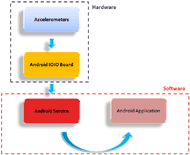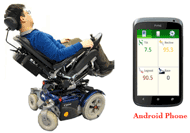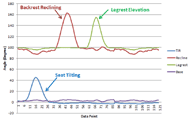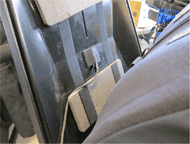Yu-Kuang Wu, MS PT1,2, Hsin-Yi Liu, MS PT1,2, Josh Brown, BS1,2, Annmarie Kelleher, MS OTR/L1,2, Hongwu Wang, PhD1,2, Rory A. Cooper, PhD1,2
1Department of Rehabilitation Sciences and Technology, School of Health and Rehabilitation Sciences, University of Pittsburgh
2Human Engineering Research Laboratories, Department of Veterans Affairs Pittsburgh Healthcare System
Pittsburgh, PA, USA
ABSTRACT
Powered wheelchairs equipped with powered seat functions allow users to adjust their posture independently for assisting with daily tasks and preventing secondary complications such as pressure ulcers, orthostatic hypotension, autonomic dysreflexia, and so on. The goal of the Virtual Seating Coach (VSC) is to help educate powered wheelchair users about the usage of these seating functions to meet each person’s individual needs. Our ongoing study has preliminarily found that some subjects have increased their compliance with clinical recommendations of powered seat functions usage with the use of VSC. In order to allow more individuals to benefit from VSC, we are developing a smartphone-based VSC system to overcome some drawbacks from the previous system, including the complicated and time-consuming process of installing sensors and encoders and the large size of the display tablet which could interfere with transfers and daily tasks. This new development is using accelerometers to detect angles of seat tilt, backrest recline, legrest elevation and wheelchair base inclination. These accelerometers are connected to an Android IOIO board which converts the analog sensor signals into digital data and sends it to an Android smartphone. This new smartphone-based system is still in the development process. In this paper, we want to demonstrate that the new system has the ability to obtain consistent data of powered seat functions usage.
INTRODUCTION
Powered wheelchairs with powered seat functions are prescribed for wheelchair users who are unable to adjust their postures or manage their seating pressure independently because of motor and/ or sensory impairments. [1] The powered seat functions not only provide users with dynamic postural support [2] and help them perform pressure relief, but also provide management of complications such as orthostatic hypotention, autonomic dysreflexia, edema, and so on. [3] Also, appropriate seating adjustment may improve driving safety [4] and improve users’ daily function. [3] Effective user training is very critical for novice power seat function users. A tailored reminder to educate powered wheelchair users about appropriate powered seat function usage by providing feedback based on their usage can be a valuable tool to extend the training beyond the clinical setting and into real world situations.
We have been developing and testing the Virtual Seating Coach (VSC) [5, 6], which is a system facilitating powered wheelchair users to utilize powered seating functions based on clinical recommendations. The VSC computer receives seating angle, seat height, wheelchair occupancy, and driving status data from multiple encoders and sensors. The VSC program compares the seating function usage data with a clinician's recommendations and provides appropriate reminders. In the pilot test study of evaluating VSC, the results have shown that VSC increased subjects' compliance with clinical recommendation of powered seat functions usage, such as increasing the frequency of performing pressure relief. [7] The preliminary findings encourage us to develop an easily installed VSC system to increase the number of individuals who can benefit from this application. One of the goals is to overcome the challenges of the complicated and time-consuming process of installing the encoders and sensors of the current VSC system, which also requires permanent modifications to the wheelchair to accomodate the shape and size of the encoder.
Currently, several types of devices can be used to detect the angular change of an object. For example, accelerometers are used to detect the orientation of an object by calculating three axis acceleration static values relative to gravity. Gyroscopes are used to measure the angular acceleration of an object. Inclinometers are used for detecting the incline angle. Curently in the development, we are investigating the potential of using accelerometers to measure the angular change of seat tilt, backrest recline, legrest elevation and wheelchair base inclination, since it is simple to compute the angle via two vectors from two axes.
Another challenge of the current VSC system is using a tablet mounted on the armrest to display information and instruct users, as well as running the program and processing the data in real time. In the pilot study, some users found that the size and location of the tablet interferes with transfers and performing activities of daily living, such as food preparation and eating at the table [7]. A compact display and computing device may solve the size issue. With the advance of portable devices combining telephony and computing, smartphones are not only a regular communication device, but also provide personal digital assistant tasks, multimedia viewing, and access to the internet. The number of smartphone users has increased year-to-year. Converting VSC program into a user-friendly smartphone app with sensors that can be attached with simple hand tools may increase the potential of utilizing VSC in clinics. Therefore, the purpose of this current development is to test the feasibility of using an Android smartphone to acquire consistent angular change data of seat tilt, backrest recline, and legrest elevation measured by accelerometers.
METHOD
Hardware
Four accelerometers (DKSB1002A, DigiKey Electronics) are used in this development. A supply of 3.3 volts is provided to the accelerometers via an Android IOIO board (Sparkfun Electronics). The accelerometers’ signal output is connected to an analog input port on the Android IOIO board for analog to digital conversion. This digital data is sent to an Android smartphone via USB cable.
 Figure 2. The locations of accelerometers were placed to measure the tilt, backrest, legrest and base angle in this study.
Figure 2. The locations of accelerometers were placed to measure the tilt, backrest, legrest and base angle in this study.Two vectors (y and z axis) are used to determine the tilt angle of the accelerometers. (Figure 1) These four accelerometers are placed on the seat pan, backrest, legrest, and the wheelchair base to detect the tilt, recline, legrest, and wheelchair base angles. (Figure 2) In order to increase the efficiency of installation and attempt to apply our system on various types of powered wheelchairs, the accelerometers are attached on the powered wheelchair using hook and loop fastener.
Software
 Figure 3. The flowchart shows the concept of how the accelerometer data is sent to the smartphone and how the smartphone handles the data.
Figure 3. The flowchart shows the concept of how the accelerometer data is sent to the smartphone and how the smartphone handles the data.The Eclipse IDE with Android Developer Tools plug-in is used to develop the application on the smartphone for gathering the accelerometer data. The data collection runs as a background program which is called a service in the Android system. This service keeps requesting the Android IOIO board to send the accelerometer data to the phone. Once the service obtains the data, the data is broadcasted within the system and other applications are able to access the data. (Figure 3)
RESULTS
 Figure 4. The user interface shows the seat tilt, backrest recline, legrest elevation and wheelchair base inclination information.
Figure 4. The user interface shows the seat tilt, backrest recline, legrest elevation and wheelchair base inclination information.Figure 4 shows the interface displaying the angles for seat tilt, backrest recline, legrest elevation and the position of the wheelchair base, which indicates that the smartphone can successfully obtain the angular data measured by the accelerometers.
Figure 5 shows one minute (sampling rate: 2 points /second) of data collection from four accelerometers, when the wheelchair was on level ground. The data points have some slight fluctuations when the powered wheelchair is static, but still maintain stable values.
 Figure 5. The data points collected from four accelerometers over one minute. (Sampling rate: 2 points/ second)
Figure 5. The data points collected from four accelerometers over one minute. (Sampling rate: 2 points/ second)Figure 6 shows the way that the accelerometers are attached on the seat pan, backrest, legrest and the wheelchair base with hook and loop fastener. This will increase VSC installation efficiency, and is also user-friendly since it can be installed on various types of powered wheelchairs with simple hand tools.
Table 1 presents the devices used to detect the powered seat functions between the current VSC system and the new VSC system. As can be seen, the new VSC system simplifies both the sensors used to detect the powered seat functions, and therefore the cost for the raw material and installation can be significantly decreased as well.
|
Current VSC System |
|---|---|
Devices |
3 x encoders (tilt, recline, legrest angle) 1 x inclinometer (wheelchair base inclination) 1 x DAQ box 1 x Tablet 4 x Customized cases for all encoders and inclinometer |
|
|
|
New VSC System |
Devices |
4 x accelerometers 1 x Android IOIO board 1 x Android smartphone 1 x Customized case for Android IOIO board |
DISCUSSION
This development is to investigate the feasibility of using the accelerometers to reliably detect the tilt, recline legrest and wheelchair base angles of powered wheelchairs on an Android smartphone, which can be applied to provide feedback and guide powered wheelchair users to use their powered seat functions. This development intends to overcome some challenges we are facing in the previous Virtual Seating Coach system. The improvements we are trying to make in this smart-phone base VSC include (1) User-freindly installation: we used accelerometers to detect the angle change. The accelerometers were easily attached on the wheelchair by using hook and loop fastener; therefore, this advantage not only allows our system to be applied on various types of powered wheelchairs, but also decrease the complexity of sensors’ installation. (2) Displaying the information on a smartphone: A smartphone has a smaller size than a tablet which can incrase the flexibility for placement to not interfere with wheelchair transfers and daily tasks.
Future Work
This is a preliminary design for the new version of the Virtual Seating Coach system. The purpose of the Virtual Seating Coach system is to educate powered wheelchair users about proper usage of powered seat functions. The pilot study has shown the postitive impact of VSC on real power seat function users [7]. This consolidates the motivation to develop the smartphone-based VSC system. Since we are able to use a smartphone to obtain data from accelerometers to detect the activities of performing powered seat functions, the next step is to validate the angular data from accelerometer in different driving conditions. Once the angular data is valid and reliable, we can start to design and develop a friendly user interface which can present clear and correct instructions for powered wheelchair users on the smartphone platform. In addition, the accessibility of recording data for clinical use on a smartphone might be a critical issue. It is necessary to provide a simple and quick way for clinicians to understand users’ usage of powered seat functions, and give them feedback based on the data. One potential solution might be uploading the data via smartphone 3G/4G data services to a server that analyzes the data. Currently, we are developing a case for the Android IOIO that is compact and able to be attached to different types of powered wheelchairs. In addtion, a smartphone holder or cradle will need to be designed to hold the smartphone within easy reach of the user, but without impeding normal usage of the wheelchair.
CONCLUSION
The goal of the smartphone-based VSC system is to implement our seating coach on low-cost, user-friendly mobile app forms that requires no additional hardware modifications of the powered wheelchair. The availability of the VSC app will promote access to this educational tool by users and clinicians and may further advocate the importance of powered seat functions and proper user training. Our preliminary work has already shown that the smartphone can successfully obtain consistent angular data measured by the accelerometers and can also be easily and quickly attached to the wheelchair.
REFERENCES
1. Trefler E, Schmeler M. State of the science white paper on seating for postural control. In: Brubaker CE, Brienza, DM, editors. Proceedings of Wheelchair Seating: A State of the Science Conference on Seating Issues for Persons with Disabilities; 2001 Feb 19–20; Rehabilitation Engineering Center on Wheeled Mobility and the School of Health and Rehabilitation Sciences, Orlando, FL. Pittsburgh (PA): University of Pittsburgh; 2001. p. 21–26.
ACKNOWLEDGEMENTS
This research is supported by Quality of Life Technology Engineering Research Center (QoLT ERC) (EEC-- 0540865) and the VA Center of Excellence (B3142C). The contents of this paper do not represent the views of the Department of Veterans Affairs or the United States Government.

